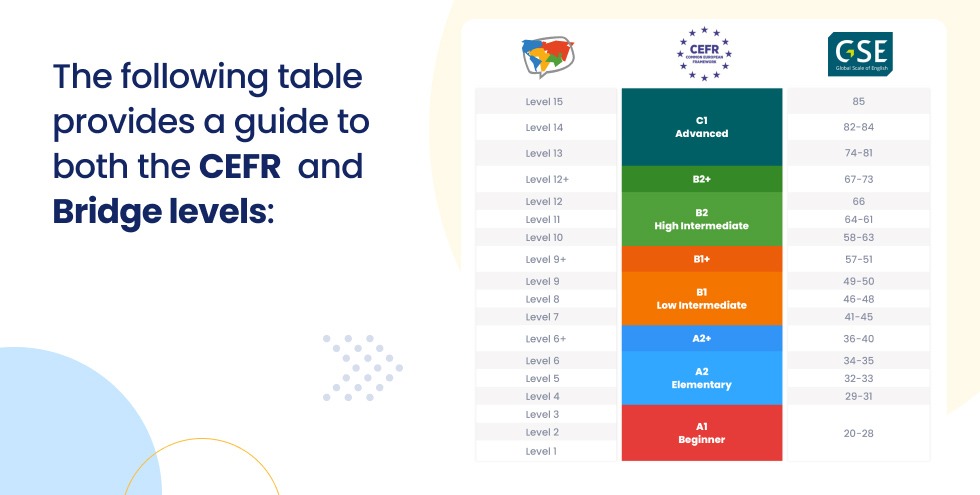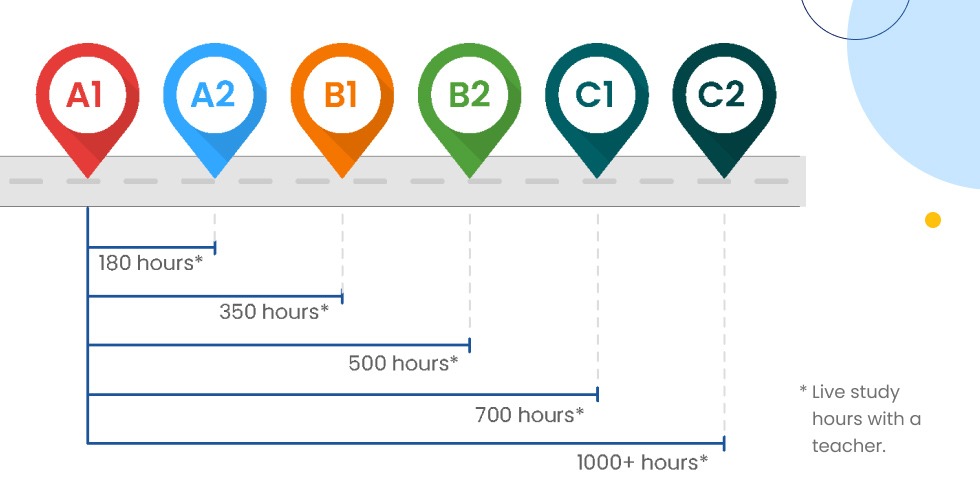At Bridge, we work with executives and professionals eager to improve their English skills for business purposes. One of the most common questions we get asked is, “How long does it take to learn English?” While there’s no one-size-fits-all answer, we can provide insights to help set realistic expectations and guide you on your language learning journey.
Factors Affecting Language Learning Speed
Many things influence how long it takes to learn English, but the following 10 factors are the most important to consider.
1. Prior language learning experience
If a person has previously learned a second language or has experience with language learning techniques, they may have an advantage in acquiring English skills more quickly.
For example, if a student in India has grown up speaking Hindi and also learning the local state language, then picking up English may prove easier. A student like this already knows to look for different sentence structures, verb conjugations, and correct spelling. Even though every language is different, they all have rules and exceptions to the rules, and having learned a language before can impact the amount of time it takes to learn English.
2. Native language of the learner
Ever wonder why Germans tend to speak such good English? It’s because English and German share the same provenance. The native language or mother tongue of an individual can affect the learning speed of an additional language. Some languages share similarities with English, such as vocabulary or grammatical structures, which can facilitate the learning process.
Conversely, those who speak a Romance language like Spanish or Italian may find it harder to perfect their English.

3. Instructional methods
People have unique learning styles, such as visual, auditory, or kinesthetic. Tailoring the learning approach to match one’s preferred style can enhance comprehension and retention of English language skills. In fact, learning should be personalized for individual learner needs, as there is no one-size-fits-all method.
Business English teachers with Bridge Corporate Language Learning combine the CEFR with the GSE (Global Scale of English), which expands learner levels from six to a 10-90 scale. The GSE maps students’ target performance across a range of skills and domains, giving teachers a roadmap of learning objectives to inform their teaching strategies and course materials.
Essentially, the CEFR provides teachers with universally understood descriptions of English proficiency levels, and the granular scale of the GSE specifies what a learner can do within each of these levels. Using these tools in tandem can help fast-track learning progress.
Explore more ways to hyper-personalize Business English training.
4. Use of authentic resources
This goes hand in hand with instructional methods as access to authentic resources that put language learning in the context of job-specific tasks can influence how long it takes to learn English. A task-based learning methodology, for example, may provide authentic resources for the learner to practice writing emails or reports, or a variety of other typical job-specific tasks. With effective instructional techniques and support, such as using language learning apps, project-based tasks, and working with a tutor, task-based learning will optimize the learning experience.
As Business English language learners will often engage with other non-native English speakers in their professional capacity, Bridge teachers also use course materials that teach English as a global language, recognizing varied accents, dialects, and cultural nuances.
“We use Pearson’s materials,” said Bridge’s Academic Operations Coordinator, Umut Ergöz, “which have lots of listening materials where the speakers are speaking with Japanese accents, Indian accents, Australian accents, Scottish accents, and so on.”
He also shared that Bridge teachers use video as well to expose students to other ways people speak and use English.
Read about five ways to use AI as your personal teaching assistant.
5. Age of learner
Generally, younger learners tend to acquire languages more easily than adults. Children have a higher degree of language plasticity and tend to pick up languages through immersion and natural exposure. However, this doesn’t mean that adults cannot learn English proficiently; they just may approach the learning process differently. An adult student may feel self-conscious speaking aloud or struggle to find time to practice the language, but with the right instructional methods, rapport with a teacher, and flexible course schedules, there are workarounds to address challenges for adult learners.
Many adult students use language apps like FLOW Speak, Duolingo, or TalkPal for conversational practice. Teachers can provide information about resources like these to use for extended learning beyond the classroom.
For example, the FLOW Speak app features speaking and listening practice lessons, many of which are geared toward using Business English in various situations.
Read more about some of the best digital tools for teaching English online.

6. The learning environment
The learning environment, including access to resources, exposure to native English speakers, and immersion opportunities, can greatly impact learning speed. Living in an English-speaking country or regularly interacting with native speakers tends to accelerate fluency. For example, if somebody who only speaks Spanish moves to England, the natural exposure to English will likely accelerate language acquisition.
Whether teaching online or in person, teachers can do a lot to create a fun, engaging, and effective learning environment for their students. Using realia, authentic objects from real life, in the classroom makes learning experiences more memorable and creates connections between the objects and language concepts.
Teachers can also integrate games and activities in instruction, including with adult students, to help students relax, make learning fun, and provide low-stakes ways for students to apply their learning.
Find out more about using games in the adult ELT classroom.
7. Motivation and dedication
How long does it take to learn English? A lot of that also depends on the level of motivation and dedication a person brings to their language learning journey. A highly motivated person can significantly reduce the time required to learn a language. Consistent practice, a positive attitude, and a genuine desire to learn English can put a learner on the fast track to fluency.
Teachers can influence the motivation level of their students as well. Facilitating engaging classes, using realia, and instituting games and activities can make learning fun and inspire learners to give it their all.
The GSE is another effective tool for motivation. The expanded language level scales show micro-learning progressions that can’t be seen in the shorter scale of the CEFR. Leveraging the GSE allows teachers and students to track and celebrate progress made toward the next CEFR level.
Lastly, teachers can also create opportunities for rewarding learning experiences. Acknowledging the progress of students through personalized verbal or written feedback, progress reports, and certificates and rewards builds confidence in students and increases their motivation.
Learn more about effective strategies for giving feedback to ESL students.
8. Starting proficiency level
The initial level of English proficiency influences the learning timeline. Beginners may take more time to grasp the basics, while those with some prior knowledge may progress at a faster rate. Even a person who consumes more media in English will be at a better starting point than someone who does not.
The amount of time needed to learn English also depends on the goals each person has. Some people may want to be completely fluent, while others are satisfied with reaching the proficiency necessary to complete their specific job tasks.

Bridge teachers leverage adaptive learning technology of placement tests and other student assessments to determine students’ English levels at the start of language training and to assess progress. Tests like Linguaskill and Pearson’s Level Test align with the CEFR, which can then be combined with the GSE to create customized learning paths.
Interested in teaching Business English? Explore Bridge’s Specialized Certification in Teaching Business English.
9. Cultural and social factors
Oftentimes, there are common misconceptions about learning a language. Some may believe that simply completing lessons and tests is the way to learn English. This is especially true in countries where second languages are not as common. For example, people in European countries who are exposed to various languages throughout schooling understand that learning English is a lifelong process. On the other hand, in a country like the United States where there is not a common culture of learning an additional language, there’s more often the misconception that it can be learned quickly.
10. Natural aptitude
Some learners simply have a natural talent for picking up a new language. Language aptitude encompasses factors such as memory, analytical skills, and the ability to recognize patterns.
While some people may find it more difficult to learn English, it does not mean that it’s a farfetched goal. With proper instruction and individual attention, everyone can advance with language acquisition as long as there is some degree of motivation.
These 10 factors influence the amount of time it takes to learn English. Of course, individuals who start young and are in an immersive environment will have an advantage; however, with the right language training, there are many ways to increase the speed and efficiency of the learning process.
Stages of English Proficiency
The Common European Framework of Reference for Languages (CEFR) is the best-recognized framework for measuring stages of language competence. This framework is considered an international standard, providing guidance for measuring language ability at six levels:
- A1 (Beginner)
- A2 (Elementary)
- B1 (Intermediate)
- B2 (Upper Intermediate)
- C1 (Advanced)
- C2 (Proficiency)
Each CEFR level represents a significant milestone in language proficiency, encompassing various skills such as speaking, listening, reading, and writing.
At Bridge, we developed a set of 18 micro-levels of language proficiency that are based on the Global Scale of English (GSE) and align with the CEFR. We created this set of levels to provide learners with a more granular recognition of progress within the broader CEFR framework.

Estimated Learning Times
While individual progress varies, research and experience suggest the following timelines for English language acquisition:
- A1 to A2: 180 hours of guided study
- A2 to B1: 350 hours of guided study
- B1 to B2: 500 hours of guided study
- B2 to C1: 700 hours of guided study
- C1 to C2: 1000+ hours of guided study

It‘s important to highlight that these hours are cumulative. For example, it takes 180 hours to progress from A1 to A2, 350 hours to move from A1 to B1, 500 hours to move from A1 to B2, and so on. This cumulative approach aligns with our educational framework, where we estimate approximately 200 hours per CEFR level in our courses.
At Bridge, we’ve conducted internal studies, which show that to progress inside our 18 micro-levels scale, a minimum of 45 hours of guided study is required. The above guarantees progressive and measurable learning aligned with participants’ needs and international standards. This ensures that every participant can achieve their language goals effectively, supported by a solid foundation of practical knowledge.
However, it must be remembered that these are rough estimates and can vary significantly based on the factors mentioned earlier. Additionally, the time required to progress through higher levels tends to increase, as the complexity of language skills and nuances becomes more pronounced.
The Reality of Language Learning
Learning English, or any language, is not a linear and equal process. Learners often experience periods of rapid progress followed by plateaus where improvement seems to slow. This is a normal part of the language learning journey and shouldn’t be discouraging. Moreover, language proficiency is multifaceted. A learner might progress quickly in reading comprehension but struggle with speaking fluency. It’s common for different language skills to develop at varying rates. Consistent practice is essential for success. Just like physical fitness, language skills can deteriorate without regular use. Continuous engagement is vital, not only for maintaining proficiency but also for steadily building and enhancing language abilities.
Setting Realistic Goals
Instead of focusing solely on achieving a specific proficiency level within a set timeframe, we encourage our learners to set realistic and achievable goals. These might include:
- Being able to participate in a business meeting conducted in English
- Giving a presentation on a familiar topic
- Writing professional emails with confidence
- Understanding English-language news broadcasts
By breaking down the language learning process into specific and actionable objectives, learners can track their progress more effectively and stay motivated.
We’re Teacher-Powered!
At Bridge, we believe that consistent, guided practice is the cornerstone of language learning success. Our teacher-powered approach ensures that learners receive expert guidance and personalized instruction throughout their journey. Our experienced educators create tailored learning plans that incorporate daily English practice through various mediums – from structured conversation practice to curated reading materials, podcasts, and English-language media. This comprehensive approach, led by our global network of professional language instructors, contributes significantly to language acquisition and retention.
The Importance of Consistency and Practice
We emphasize the importance of regular, teacher-guided sessions combined with self-study. Our instructors work closely with learners to design personalized learning plans that balance intensive, expert-led instruction with consistent self-practice. This approach ensures that even short, frequent study sessions become highly effective, surpassing the benefits of longer, sporadic ones. By leveraging our teachers’ expertise and our cutting-edge learning platform, we create a dynamic and engaging learning experience that keeps students motivated and on track toward their language goals.
Conclusion
While the journey to English proficiency may seem daunting, it’s important to remember that every step forward is progress. Language learning is a lifelong endeavor!
At Bridge, we’re committed to supporting our learners throughout their English language journey, providing expert guidance, personalized instruction, and encouragement every step of the way. Remember, the key to success lies not in how quickly you reach your goal, but in the consistent effort and dedication you bring to your language learning experience.











